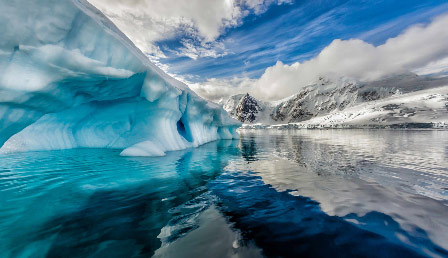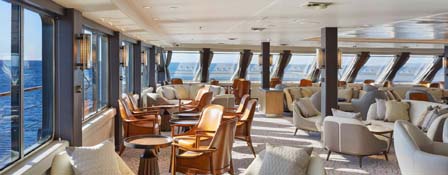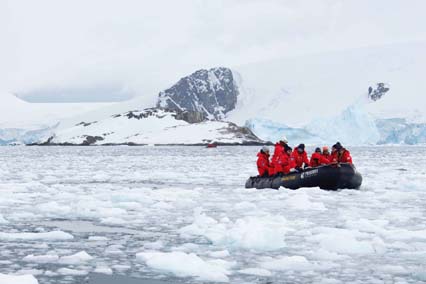Published 28th Jun. 2021
Reading time
The White Continent was always going to be home to some impressive ice bergs - but what lay ahead was quite simply stunning and out of this world. Along our journey we experienced myriad types, shapes and sizes of ice resembling everything from dragons to mushrooms. According to the illustrated Glossary of Snow and Ice (yes, that is a real thing) there are around 40 classifications of snow and ice. Here a few of those that we experienced in Antarctica...
Calving
The sound of calving (the breaking away of a mass of ice) was a frequent and eerie interruption to the silence of Antarctica, and was usually followed by a frantic search of the horizon to watch said ice breaking from a berg, sliding down a glacier to form a new ice berg or just crashing into the ocean. It also acted as a rather sobering reminder that zodiacs and kayaks (which we used every day) must stay at least three times the height away from any ice...
Fast Ice
One of the many, many highlights of this trip was the Captain rather skilfully parallel parking our 6,230 gross tonne ship next to a sheet of fast ice (sea-ice which is attached fast to the shore, ice wall or between two ice bergs), lowering the gang way and allowing us off to trek a couple of kilometres across the 2m thick fast ice. Not only was this is a first for us, but also our Captain who had been leading voyages to Antarctica for over 20 years. We were joined by Adelie Penguins, which playfully waddled over to greet us, Crabeater Seals which merely grunted at us from afar and we even glimpsed a Weddell Seal basking in the sun.
Tabular Berg
It seemed like a normal ice berg in the distance, but after an hour had passed and we were still cruising towards, at 13 Knots, it was obvious this was no normal piece of ice. It turned out to be a 2.5km long, 50m tall tabular berg (a flat topped ice berg, most typically formed by calving from an ice shelf). There were horizontal bands running along the length of this enormous berg, akin to the lines found on a tree trunk.
The tabular berg we saw was large enough to land a Boeing 747 on, but was tiny compared to some of the monster tabular bergs found in Antarctica - the largest on record being 31,000 square kilometres - larger than Belgium.
Floe
Pretty much does what it says on the tin - dotted across the horizon was lots of floating ice, often frequented by sleeping seals and penguins, or resting birds.
Pack Ice
We managed to go out kayaking most days and encountered lots of open pack ice (composed of floes, seldom in contact and with many leads, ice cover 40% to 60%), following the existing leads, or breaking through the thin ice covering (up to 10 cm) with our paddles to form new paths.
Below The Antarctic Circle
When journeying below the Antarctic circle (at 66°), we noticed a distinct difference between the ice: the introduction of fast ice, pack ice and a sense that the ice was surrounding us.
In the words of one of my fellow cruisers, ""It was the wildlife that first brought me to Antarctica, but it's the Ice that makes me come back time and time again.""

Travelling with us means enjoying a trip that has been meticulously crafted by our team of experts, each knowing their specialised country like the back of their hand. Tailor-made with originality, quality and cultural immersion in mind, we can customise itineraries based on your taste, be that an architecture aficionado, a food fanatic or an environment enthusiast. Working hand-in-hand with local Concierges and guides, we’ll uncover spots perfect for you. From hidden gems to iconic landmarks, our curated experiences are supported by an array of additional services, including a 24-hour helpline and an app full of recommendations.
ENQUIRE NOWPractical advice and inspiration for your next trip

Until space tourism becomes a thing, Antarctica remains the final frontier. There was a time when the only way to visit Antarctica was by ship from Ushuaia in Argentina, travelling through the notoriously rough seas of the Drake Passage. Although this is still very much an option, it is increasingly possible to bypass the crossing and even, in some instances, bypass the coast as well en route to the holy grail of the pole itself.
17th August 2021 - Antarctica Adventure

Hebridean Sky In the spring of 2016 a $6.5m refit transformed the 55 cabin Sea Explorer into the all new Hebridean Sky, one of the world's best small ships. Famed for her effortless elegance, high levels of comfort, experienced crew and adventure, the Hebridean Sky is the perfect remedy for someone looking for an escapade with a hint of luxury. The refurbishment welcomed a new Owners Suite with separate living room and bedroom areas, improved WiFi signal throughout the vessel and significant eco changes and waste disposal improvements to reduce the vessel's carbon footprint.
28th June 2021 - Antarctica Hotels

They always say that you shouldn't meet your idols. In travel terms, Antarctica has been that idol for me; ever-present at the top of my bucket list. The question was - could it live up to my extremely high expectations? Living up to Expectations A few weeks ago, I was fortunate enough to meet my idol. I had of course, as with most places on earth, already seen a vast array of photos, read various books and articles and watched numerous Attenborough masterpieces on Antarctica so there should have been no real surprises.
28th June 2021 - Antarctica Adventure

Our team of destination experts will get to know you and your unique requirements for your holiday

We work with you to build an ultra-personalised holiday itinerary with your choice of accommodation, experiences and activities

All of our holidays include little extras designed to make a big difference to your trip, from fast-tracking you through airport check-in and security to our network of local Concierges